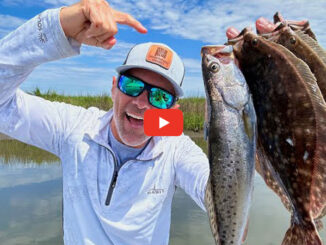
Kayak angler shares tips to land some doormats
For kayak anglers fishing a Cajun Slam tournament — where they need to catch a flounder, a speckled trout and a redfish — the always elusive doormat has definitely shattered the dreams of many hoping to finish in the money.
But Mike Malone, president of the Elite Kayak Club out of Big Lake, is a firm believer in Berkley Gulp’s chartreuse Swimming Mullet when he needs to find a flounder. It works around Big Lake, and just about any other coastal marsh across the coast, he said.
“If I have money on the line, I’m dragging a Gulp,” Malone said with a chuckle. “If anything, I’ll change from a chartreuse to a pearl white. From there, I might throw a Mantis Shrimp in nickel penny to change up the profile.”

Malone typically uses an 1/8-ounce jighead in the fairly shallow water he fishes in his kayak.
“I like throwing an 1/8(-ounce), but I know guys who throw ¼- and 3/8-,” he said. “If it’s a deep hole and you want to get down there fast, just throw a little heavier weight.”
The key to finding flatfish
The key, Malone said, is to locate a drop-off, which will give you the best opportunity to catch a flatfish.
“I’m trying to find a cut leading into a marsh that’s got a depth difference. So a drop-off of just a couple of feet makes a big difference,” he said. “They’re sitting in these cuts with water movement in or out, and they’ll just be in there gorging.
“Work it down the ledge, so throw it along the grass and let if fall. They’re waiting for more baitfish to come over the top of them.”
Most of the action happens up and down the Calcasieu Ship Channel from Hackberry to the Cameron Jetties, said Capt. Kirk Stansel, one of three brothers who co-own the Hackberry Rod and Gun Club. Any nooks or points can harbor the hungry flatfish, or they might be on a ledge in 10-foot depths, he said.
Some of the more likely places to hook up with doormats are at the Older River Washout and the jetties. Look for eddies in the shallows and fish slowly, dragging the bottom with your presentation, and probe the depths.
Another hotspot that gives up plenty of flounder to anglers in boats as well as wade fishermen is the area around Louisiana 182 between the Gulf of Mexico and the Cameron Ferry.
Malone, 34, of Ragley, had been hammering male trout in the Big Lake area in March that had already returned to the marsh from offshore. The bite isn’t exactly subtle, but Malone said doormats are famous for spitting the hook.

“They thump it — they really stop the bait,” he said. “If you’re reeling in bumping the bottom on a tight-line, your line will jump. From that point, they have it. They’re eating it, so you don’t have to rip the lips off of them like you do a bass.
“It’s more like reeling down and setting the hook at the same time.”
Some additional flounder tips Malone shared: Tie on a fluorocarbon leader, and bring plenty of tackle.
“You are literally just bumping it on the bottom, so you will snag up on oysters if they’re present,” he said. “Bring a couple bags of baits — know that going in.”
The fluorocarbon leader has a couple of advantages, he said.
“I throw 50-pound braid, but I tie on a 15-pound fluorocarbon leader to allow a little stretch in that line. I used to tie on straight braid, but I’ve had problems breaking hooks and bending hooks out because there is no stretch with braid,” Malone said. “Plus, it also helps out when you get a little fray — the fluorocarbon is easy to retie.”
